
I belong to Chennai, Tamil Nadu but my childhood was spent in Hyderabad, Andhra Pradesh. I started my married life in Lucknow, Uttar Pradesh and presently live in Bangalore, Karnataka. My morning begins with a ritual where I sweep and mop the threshold of my house and draw a Kolam. It has been a large part of my life.
This art form goes by the name of Kolam in Tamil and Malayalam, Muggu in Telugu and Rangoli for the rest of India. The states maybe divided by their language, food habits and customs but they are united by this art form.
Freshly-drawn on the threshold of homes, temples, business establishments mostly in the early hours of the morning called the Brahma Muhurtam (an auspicious hour of the day when the creator Lord Brahma along with other deities are closest to the earth), this serves as a mark of welcome to all starting with Goddess Lakshmi who is revered for wealth and prosperity.
The everyday walk on balmy mornings in the city I live, very soon turns into a stroll along artistic pathways. Every other house would be either sporting a freshly-drawn kolam or would have the lady of the house bending over to let the rice flour drop in a thin line from between her thumb and forefinger, kept a few inches above the ground, her brows drawn in concentration, her mind working on the pattern that she must have previously decided on.
Kolams were such an integral part of all festivals, functions, marriages, birth and other auspicious occasions, that a house with a missing Kolam was one of the non-verbal communications for some bereavement in the family.
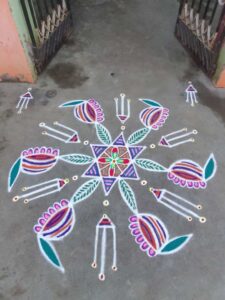
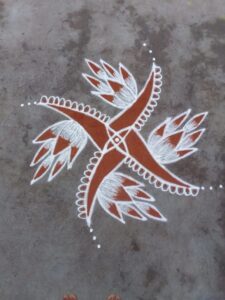
They are an amalgamation of geometry, strategy and adroitness not to speak of creativity. The lines can range from straight lines to wavy lines, curved lines to zigzag lines, thin or thick, single strands or multiple ones or a variation of many patterns to draw a design. Most of the forms are abstract and it depends a lot on the occasion or celebration. It can vary from simple to splendorous. The designs can veer from the conventional forms like the lotus flower or sacred pot to more symbolic forms like the union of male and female in a six-pointed star which is the most common of this art form.
The geometrical shapes and designs are sometimes combined and overlapped depending on the creative ability of the artist.
The most striking feature of the kolam is the transitory and impermanent nature of the same. While the basic tenet of the art form is to ward off evil and negative forces and welcome positivity and prosperity, it also serves as food to the ants, birds and other small creatures thus taking care of the ecological issue and being a contributory part of the food chain as the powder is either made of rice flour or edible seeds. Hence, by the end of the day, it fades away depicting the transitory nature of life.
Creating a kolam can take anytime between a few minutes to few hours and it depends on the occasion they are made for. The cycle is repeated each morning thus depicting the continuity and the designs show innovation and creativity. I remember reading somewhere that kolams give a wide perspective to everyday life due to its diversity.

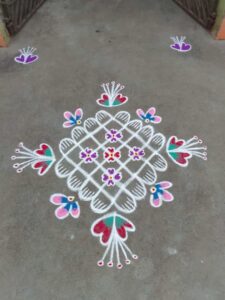
Embarking on this project can improve our problem-solving skills. As we draw a grid with dots and try to connect them to a design of our own, we end up connecting and ensuring that all points are enclosed by a drawing-line, thus sorting out the mess in our mind too. Most of these captivating patterns are first tried with paper and pencil or on floors in the free time before they are tried outside on the threshold. There are frequent contests so that the young learn the traditional style from the older lot. Often enough, there is a healthy competition going on among fellow Kolam- lovers and more intricate the designs, the more pleasure is derived.
Kolams plays a very important role with the ecology and the environment. In the olden days, the courtyard was washed with cow dung mixed water to not just settle the mud and also provide a strong disinfectant and a deterrent for insects to enter the house. Today, Turmeric has replaced the cow dung more so in the cities.
It is also a great stress buster because as you keep track of the dots and joining them keeping in mind the several permutations and combinations, your emotions are kept tethered.

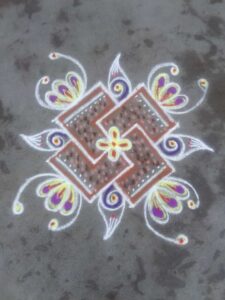
Sellam Thiyagarajan from Chennai says, “I never know of a day when my house did not adorn a kolam every morning. Now, my daughter-in-law has taken over and loves to draw a new design every day.”
Bhargavii Mani started what she calls a happy project aptly named Kolam Podu ( Put Kolam!) and says, “This project took shape when I suffered from a minor stroke and needed occupational therapy to revive my dexterity and fine motor skills. So instead of going out and trying the regular options, I decided to try something at home. I grew up drawing kolams and it seemed like the apt solution to gaining all my fine motor skills back and I wanted to share this discovery with the world and that’s how “Kolam Podu” started. I would just draw kolams outside my house every day and soon built a beautiful community. It also inspired me to release tracing books on Kolams such that it may be more accessible to everyone!”
Her theme had been to draw happiness and she is looking to expand based on the overwhelming response her tester phase had received. She hopes to arrest the rather distracted generation hooked to social media by making them do something that is their reality. “I would like to think drawing kolams would keep them culturally rooted.”
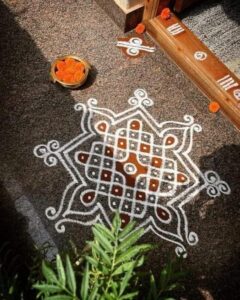
So much so, every January (barring the two when the Pandemic brought the world to a standstill) the streets adjoining the famous Kapaleeshwarar Temple in Chennai would have their annual Kolam festival. The busy street is cordoned-off for two days for those participants to create their kolams.
The below pictures were taken during the Kolam competition in Chennai last year. It is a major tourist attraction too and draws many from different states.

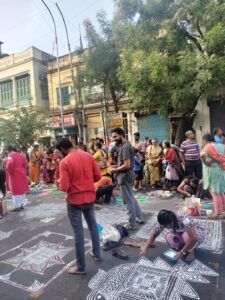
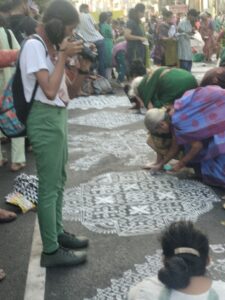
oplus_34
oplus_34oplus_34
Kolams are supposed to be in existence for over 500 years, though the origin is not documented. Yet, the beauty and the permanence of it remains etched in many households despite living life on the fast lane and this art form is often passed down generations and the aesthetic beauty can never be under-appreciated.
Image credits:
Usha Subramanian
Sellam Thiyagarajan
Ramamani Jayaram
Vidya Shanmugha
Yours truly
This blog post is part of ‘Blogaberry Dazzle’
hosted by Cindy D’Silva and Noor Anand Chawla.
![]()

15 comments
I absolutely agree with the idea that the practice is a form of meditative art; it makes so much sense that the intense focus required to weave those lines around the dots completely grounds you in the present moment, almost like an active meditation.
What a beautiful way to begin your day. I love this and i hope it always remains alive. I’ve never been inclined to make rangoli, but am seriously thinking of it now.
I grew up making rangoli in front of the house. Our lane had only two houses. A Telugu Brahmin family and ours. As you said, we used to first try it on paper or on the black stone on the floor and then outside. But, muggu that we used was made of calcium and chalk powder. The vendors would come around to sell it in the early hours. Now we are getting stencils, and I cannot bend or squat that much to make a rangoli. I wish this rangoli art is encouraged and revived to its former glory.
What a beautiful piece. Reading about how the simple act of drawing a kolam carries geometry, impermanence and mindfulness made me pause. Thank you for showing how tradition can be both ritual and meditative art.
The beauty of South India in the mornings is the fresh design drawn on the wet floor in front of each house. Each is better than the other. Beautiful kolams, Chandrika; I’m not sure though which ones are yours.
What a lovely piece — I never thought about kolam that way, but you really capture how it’s both a meditative practice and a beautiful, living art form.
Rangoli, as well call it, is an integral part of our daily chores during Diwali. However, I don’t draw it daily. It must certainly be a wonderful experience to witness every home displaying their fresh kolams everyday. The variety and creativity is astounding!
My next door neighbour is Tamil and every morning she makes this KOlam in front of the house. It looks artistic to me and she draws it so fluently and flawlessly that it impressed me always. She also makes awesome Iddli I just love it.
When I was in Bangalore, I used to see everyone practicing this ritual in the morning. Beautiful designs.
You capture the soul of kolams with such clarity and warmth that the reader feels the spirituality, artistry, and everyday grace woven into this timeless tradition.
Your post brings into focus the meditative and stress relieving part of Kolam making , so far we only knew it as a religious symbol or a decorative process. I think the Mandala art being practised by Buddhist Monks also follows the same guiding principle and is being rapidly adopted as a technique in psychology to reduce anxiety .
Your post is absolutely beautiful — you make kolam feel like both a sacred ritual and a graceful meditation. I loved how you wove in its impermanence, geometry, and ecological harmony. It’s deeply inspiring and peaceful.
The pictures of the Kolams you’ve shared are so beautiful! I am so glad your post explains everything about Kolams to readers who may not be familiar with them.
Kolams have been an integral part of the south indian culture. I still remember how amma used to be up every morning to draw them somehow I didn’t find the interest to learn then. But now post marriage I find it to be a stress buster..
I was introduced to Kolam last year when I read a children’s book called Kolam kanna. I love this art style and the way you have presented it.